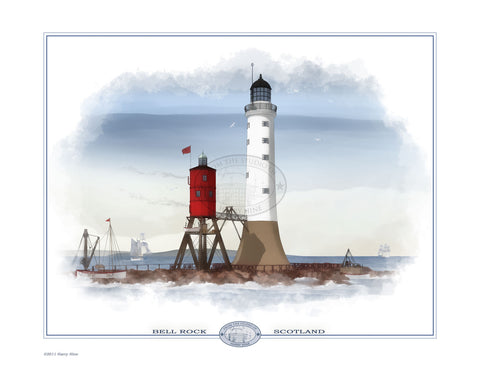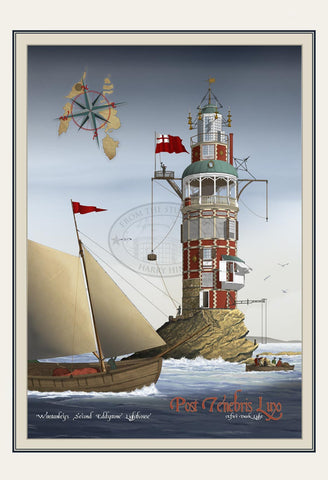Giclee print on fine art paper
Signed limited edition of 500 prints
Print dimension: 12" x 17"
The story of the first Eddystone lighthouse is as much about the remarkable man who built it, as it is about the Eddystone reef. Fourteen Miles south-south-west of the thriving English port of Plymouth lays one of the world’s deadliest reefs, the Eddystone Rocks. Due to its location and the unusual tidal currents generated by the obstruction of the rocks, many thousands of ships and crew have found themselves dashed to splinters off the unforgiving rust red reef.
In 1695 two of the Eddystone’s victims were the ships, Snowdrop and Constant. These merchant ships were partly owned by an extraordinary man, Henry Winstanley. At this time, Winstanley was a very successful London businessman, with a truly eccentric bent. His home was a favorite stop for the royal court and had hidden passages, warped mirrors and all sorts of carnival like attractions. Among his many enterprises was a thriving entertainment parlor called, “Winstanley’s Wonderful Water Works”.
Upon hearing the terrible news about the loss of his two ships and their crews, Winstanley stormed down to the city of Plymouth and demanded an explanation from the city fathers as to why there was no form of marker on the Eddystone Rocks to warn unsuspecting mariners. Winstanley was shocked to discover that a royal warrant giving permission to build a lighthouse had been given some twenty years previously. However, it was explained to him at great length that because of the huge waves that crashed over the reef and the deadly currents that swirled around them it was impossible to build a structure on the Eddystone Rocks. Unperturbed by all the sound reasoning, Winstanley declared that he would build the desperately needed lighthouse.
Winstanley set to work designing the lighthouse. In the summer of 1696, he hired a work crew and set sail for the Eddystone Rocks. In the first year of construction, 12 holes were bored into the incredibly hard rock using hammers and spikes. Work conditions were appalling. It took hours each day to sail and row out to the work site and wait on the low tide so that the chosen location for the lighthouse was exposed above the sea. It was a rare day that the crew did not have to fight the freezing wind, rain and inundation by waves crashing up and over their work site. By the end of the first building season, long iron bars were sunk into the hand drilled holes and permanently set into place with molten lead.
The second season of building was no easier than the first. A stone caisson was built around the iron spikes in order to make a flat sturdy platform for the lighthouse. Compounding Winstanley’s problems, England and France were yet again at war. The crew of a French ship landed on the rocks, armed to the teeth. After destroying the caisson, Winstanley was abducted and whisked back to France where he was thrown into goal. King Luis XIV of France eventually had Winstanley brought before him. The King made him a lucrative offer to stay in Paris which he indignantly declined and was eventually released. Luis is reported to have said that the lighthouse Winstanley was building was as important to French sailors as to the English, and he should be left alone to finish his great endeavor. Winstanley was returned to Plymouth and immediately got back to work. This time guarded by a Royal Navy ship. By early fall the caisson was rebuilt and the worsening weather brought the building season to an end.
The third year of construction was a lot easier on the crew now that they had a solid flat platform to work on. It also meant that they could camp out on the platform and they made rapid progress. On top of the caisson the tower was built. On the lowest level was a store room then a state room, above that was the kitchen and finally, the all important glass lantern.
At nightfall on Tuesday, 14th November 1698, Winstanley climbed up into the lantern and lit sixty tallow candles. In Plymouth 14 miles across the sea the light was spotted. Word spread rapidly. “The Dreaded Eddystone” was lit. Celebrations lasted late into the night. The only people not able to join the party were Winstanley and his crew. They were stuck on the rock. The weather had worsened and it was five weeks before they were able to leave. Left behind was a lonely, brave keeper charged with the single duty of keeping the light lit throughout the darkness of night, a beacon of safekeeping to all that passed.......
continued on Second Eddystone Lighthouse








